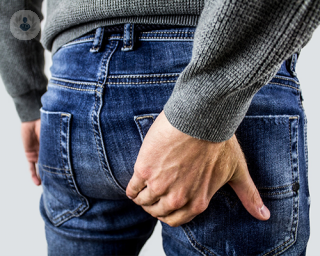Rectal prolapse
Mr Daniel Baird - Colorectal surgery
Created on: 11-13-2012
Updated on: 05-05-2023
Edited by: Conor Dunworth
What is rectal prolapse?
A rectal prolapse is when part of the rectum protrudes through the anus. The rectum is at the end of the large bowel and is where the faeces collect before passing through the anus as a bowel movement. The rectal is made up of three layers, the rectal wall lining (mucosa), a layer of muscle (muscularis propria) and a fatty tissue that surrounds the rectum (mesorectum). If the wall of the rectum sticks out through the anus, it is a rectal prolapse.
What are the types of rectal prolapse?
The three types of rectal prolapse are:
- Full-thickness rectal prolapse – which is the most common type and is when the wall of the rectum sticks out through the anus.
- Mucosal prolapse – when the lining of the rectums protrudes through the anus.
- Internal rectal prolapse – the rectum folds in on itself but does not stick out of the anus.
What are the symptoms of rectal prolapse?
A lump or swelling coming out of the anus may be noticeable when having a bowel movement. If the prolapse gets worse, it could also protrude when coughing, sneezing or standing up. If the prolapse is an internal rectal prolapse, it may not feel like the bowels are fully emptying. Other symptoms of a rectal prolapse include:
- Difficulty in controlling bowel movements
- Blood Discomfort
- An ulcer
What causes rectal prolapse?
A rectal prolapse is often associated with weak muscles in the pelvis. These are triggered by pregnancy, constipation, diarrhoea and a lot of coughing due to conditions such as cystic fibrosis or whooping cough. As women age, a rectal prolapse can happen at the same time as a prolapsed uterus or bladder. The pelvic floor muscles weaken over time or weaken after having given birth.
How to diagnose rectal prolapse
A rectal prolapse is diagnosed following a rectal examination. Further tests may be needed, which may include a proctography, colonoscopy or endoanal ultrasound.
How is rectal prolapse treated?
In children, rectal prolapse usually gets better without any treatment. Adults are recommended to treat constipation by eating high-fibre foods or taking laxatives. Surgery may be offered with the type of surgery depending on the type of prolapse, the patient’s age and a history of medical problems. There are two types of surgery.
- Abdominal surgery – involves making a cut into the abdomen and is only used for full-thickness prolapse.
- Perineal surgery – involves cutting the prolapse itself and is generally performed on older people.

















